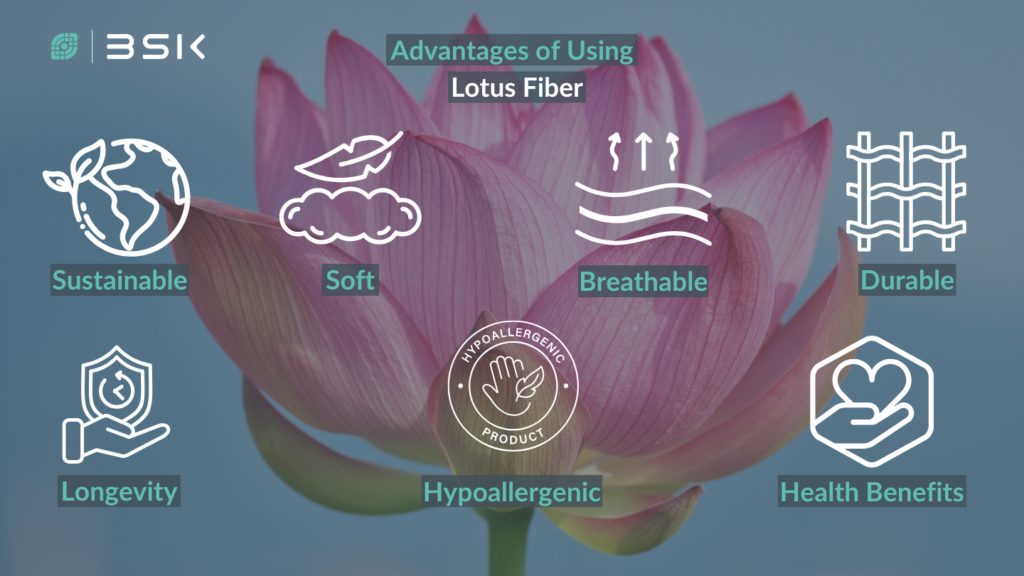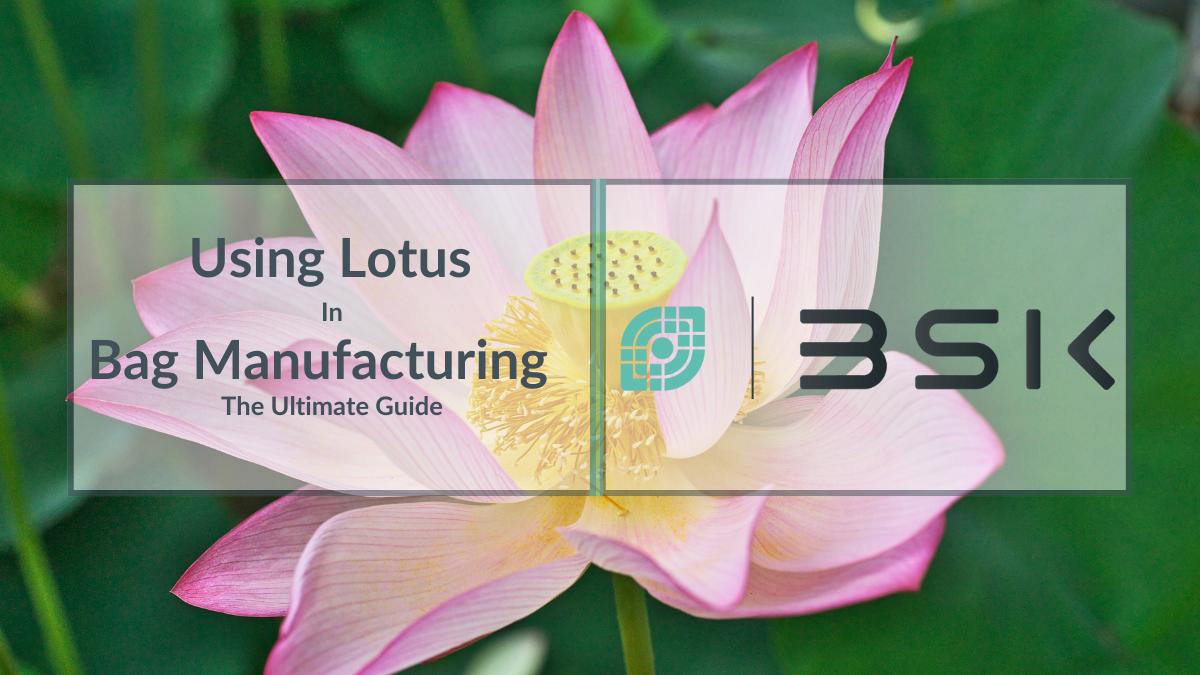Using Lotus fiber in bag manufacturing presents a unique and eco-friendly alternative to traditional materials. More and more people have appreciated eco-friendly options over traditional materials for quite some time. Sustainability is becoming a big deal, and consumers have shown a consistent interest in products that are gentler on the planet. This means that bag manufacturers need to step up their game. They should recognize that contributing to a healthier environment is key to keeping their customers happy and engaged. This trend pushes bag manufacturers to explore innovative, environmentally friendly materials like Lotus fiber.
As improvements have been made and new innovative uses for materials have emerged, the traditional applications of plant-based materials have also gained renewed interest. One of the most luxurious and expensive plant-based materials that has gained traction recently is the Nelumbo nucifera, commonly known as the lotus plant.
What is Lotus Fiber?
The lotus plant, or Nelumbo nucifera, thrives in shallow waters across Asia, particularly in countries like India, Vietnam, Thailand, and Myanmar. Spiritually, it symbolizes purity, enlightenment, and rebirth in Buddhism as it rises from muddy waters to bloom. In Hinduism, the lotus represents beauty, prosperity, and spiritual awakening, embodying overcoming obstacles. Additionally, the lotus is the national flower of Vietnam, symbolizing beauty, resilience, and purity in Vietnamese culture. It is often featured in art and traditional practices. Its ability to bloom beautifully despite growing in muddy waters inspires many, reinforcing its significance in the country.
How Has Lotus Fiber Been Used Traditionally
Lotus fiber has long been an essential material in textile production. Harvested from the stems of the lotus plant, it transforms into beautiful fabrics like scarves and shawls, showcasing its unique qualities. Additionally, nearly every part of the plant has medicinal uses, from treating liver damage to soothing coughs. Using lotus fiber is versatile and holds significant cultural importance across Asia.

Advantages of Bag Production
Using Lotus fibers in bag production offers a range of advantages that make it an exceptional choice for eco-conscious consumers and designers alike. Here are some key benefits.
Sustainability
Lotus fibers stand out for their environmental friendliness. Unlike petroleum-based materials, their production requires no harmful chemicals or polluting resources, making them an excellent choice for sustainability advocates. The cultivation and harvesting processes are also less resource-intensive than conventional textiles, positively impacting the environment.
Unique Texture and Aesthetic Appeal
The luxurious texture of lotus fibers, which blends the qualities of silk and raw linen, makes them particularly ideal for high-end bags that exude elegance and style. Their lightweight nature and soft and breathable qualities deliver a sophisticated finish that attracts consumers seeking something special.
Durability and Longevity
Bags crafted from lotus fibers are not just visually appealing; they are also remarkably durable. The natural properties of these fibers make them resistant to wear and tear, ensuring longevity beyond that of traditional materials. Additionally, a hydrophobic treatment applied during production keeps them stain-resistant, making them perfect for everyday use.
Hypoallergenic and Healing Properties
Lotus fibers are hypoallergenic, making them suitable for individuals with sensitive skin. Some users claim products made from lotus fabric provide comfort, especially for those with sensitive skin, though more research is needed to confirm these benefits This feature enhances the appeal of lotus fiber bags, particularly for wellness-focused consumers.
Limitations and Challenges of Using Lotus Fiber in Bag Manufacturing
When evaluating the potential of lotus fibers for bag manufacturing, it is important to acknowledge a number of limitations and challenges that may arise.
Durability
Lotus fabric boasts a luxurious feel and unique properties. While recognized for its durability, wear and tear can still affect natural materials differently than synthetic options like nylon or polyester. To ensure longevity, proper maintenance is crucial; neglecting this can drastically reduce lifespan. Bags designed for heavy use often need added reinforcements or blended materials to boost their durability and functionality.
Cost
Lotus fibers are more expensive due to the labor-intensive harvesting and weaving processes. This higher cost can limit accessibility for consumers seeking affordable options. Manufacturers could explore scaling production or sourcing lotus fibers through partnerships with local artisans to lower costs while supporting communities.
Environmental Impact
While lotus fibers are more sustainable than petroleum-based alternatives, production involves significant water usage and land resources. Companies should conduct thorough assessments of their supply chains to minimize their ecological footprint, focusing on the entire lifecycle of the product.
Maintenance
Lotus fabric resists stains, but you should handle it carefully to keep its integrity and appearance intact. Using the right cleaning methods is essential to avoid damaging the delicate fibers. This might discourage some potential buyers who prefer easier care options.
Blending Materials
Manufacturers could consider using materials like hemp to blend with lotus fiber, which offers durability and lower production costs while being eco-friendly. Blending lotus fibers with these materials could yield a more robust final product that retains the unique qualities of lotus while enhancing overall performance.
By addressing these challenges, producers can create bags that are not only stylish and sustainable but also practical for everyday use.
Production and Manufacturing with Lotus Fiber
Lotus fibers are carefully harvested and woven using artisanal techniques, preserving craftsmanship while producing a durable and luxurious fabric.
Harvesting and Preparation
Lotus stems are harvested from lakes, and the fibers are manually extracted by skilled artisans. These fibers are washed and dried before being woven into a fabric, a process that must be completed within a few days of harvesting to ensure quality.
Weaving and Finishing
Lotus fibers are woven using traditional techniques, often on handlooms, preserving local craftsmanship in regions like Thailand and Myanmar. The finished fabric retains the natural beauty of lotus, combining elegance with durability. Innovative technologies like hydrophobic nanotechnology enhance stain resistance. This method avoids harmful chemicals. As a result, the fabric stays practical and eco-friendly.
Design Considerations
Manufacturers need to account for the unique properties of lotus fiber during production. The fabric requires precise cutting to prevent fraying, and reinforcement during stitching to accommodate its lightweight and delicate nature. These design considerations ensure that bags made from lotus fiber are both functional and long-lasting.
Lotus fibers represent a unique, sustainable choice in fashion, combining respect for traditional methods with innovative technologies. Derived from lotus stems, these fibers promote biodiversity and help preserve aquatic ecosystems, making them a more eco-friendly alternative to conventional materials like cotton and synthetics.
Additionally, lotus fabric is biodegradable, breaking down naturally without harming the environment, which addresses issues related to waste and pollution. Certifications like the Global Organic Textile Standard (GOTS) ensure that the production process is environmentally and socially responsible.
Why So Expensive?
Lotus silk stands out as one of the rarest and most luxurious fabrics, making it an exceptional choice for bag manufacturers. Sourced primarily from Cambodia, Myanmar, and Vietnam, lotus silk is crafted from delicate fibers extracted from lotus flower stems. This fabric not only offers a unique aesthetic but also has deep cultural significance in Vietnam, where the lotus is the national flower.
The production process is both intriguing and labor-intensive, which can add value to your product line. Creating a single scarf from lotus silk can take artisans up to two months, demonstrating their exceptional craftsmanship. To produce just one 36 cm by 1.75 m scarf, approximately 9,200 lotus stems are required. With a limited harvesting season from April to October, artisans can only handle about 200 to 250 stems per day, emphasizing the dedication and skill involved.
The pricing of lotus silk reflects the time and effort invested in its production, making it a luxe choice for premium bags. Additionally, the rarity of this fabric enhances its marketability, appealing to consumers seeking unique, high-quality items. As sustainability becomes more critical in fashion, lotus silk’s eco-friendly qualities can position your bags as a conscious luxury choice.
Innovating Luxury: The Future of Sustainable Fashion with Lotus Silk
Considering the future, advancements in technology and innovative production techniques could help streamline the harvesting process while preserving artisan craftsmanship. Consider offering bags made from lotus silk to combine luxury with sustainability, elevating your brand in a competitive market.
Lotus silk has exceptional features. It offers softness like silk, breathability similar to linen, and subtle elasticity. This makes it appealing to the luxury market. For a better understanding of its production and cultural significance, watch this video from Business Insider. It offers valuable insights on using lotus silk in designs. This can enhance your product offerings and tell a compelling story. Keep an eye on this unique fabric; it represents an exciting opportunity.
Conclusion
In summary, the exploration of lotus fiber in bag manufacturing highlights its potential as a sustainable and luxurious alternative to traditional materials. The lotus plant, with its rich cultural significance and eco-friendly attributes, offers a promising avenue for bag manufacturers looking to meet the growing demand for environmentally conscious products.
The advantages of using lotus fiber include its sustainability, unique texture, durability, and hypoallergenic properties, making it an appealing choice for eco-conscious consumers. However, there are limitations to consider, such as higher costs due to labor-intensive production, the need for careful maintenance, and the environmental impact associated with water usage and land resources.
As manufacturers and consumers assess their options, it’s essential to weigh these benefits against the challenges presented. Ultimately, considering the suitability of lotus fiber for your bag manufacturing needs could lead to innovative products that resonate with today’s environmentally aware market. Embracing materials like lotus fiber may not only enhance product offerings but also contribute positively to the planet.
